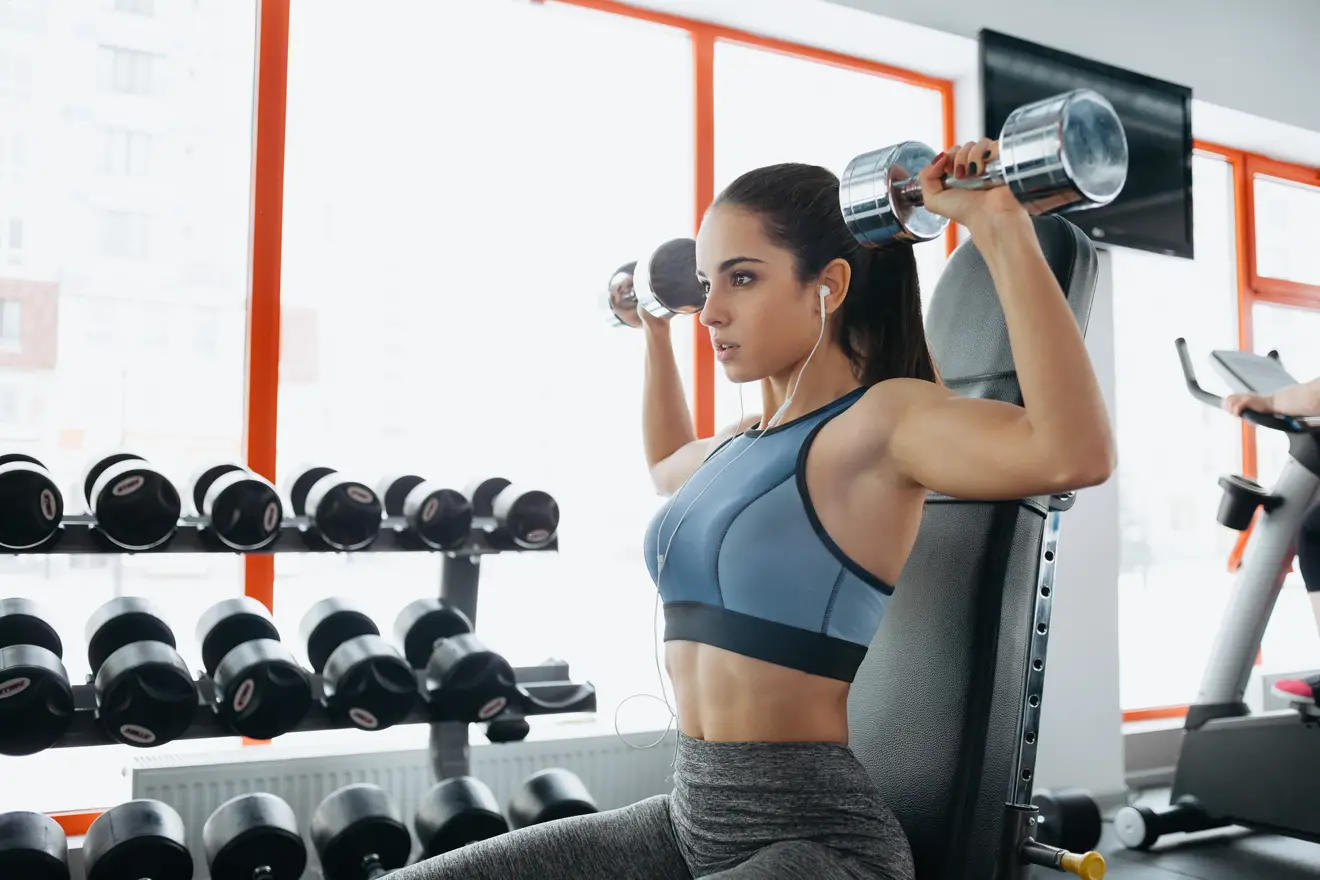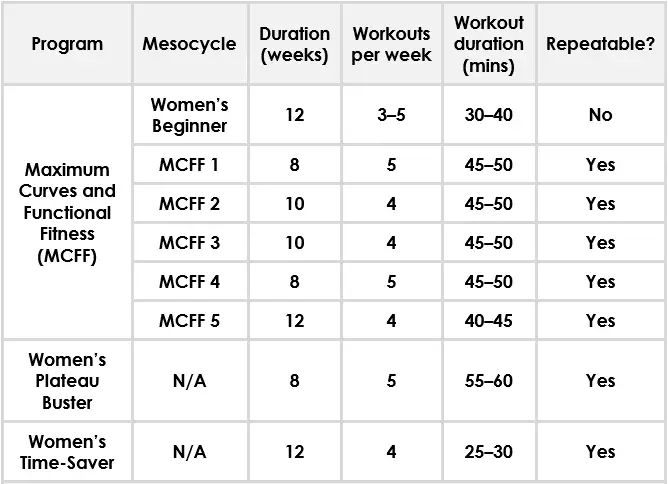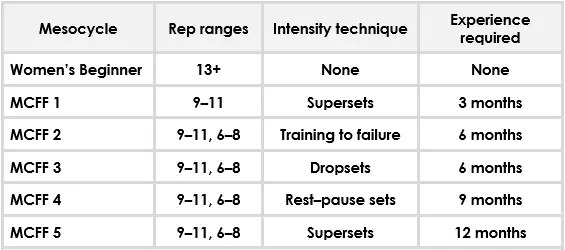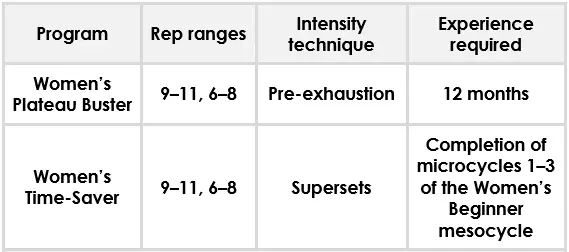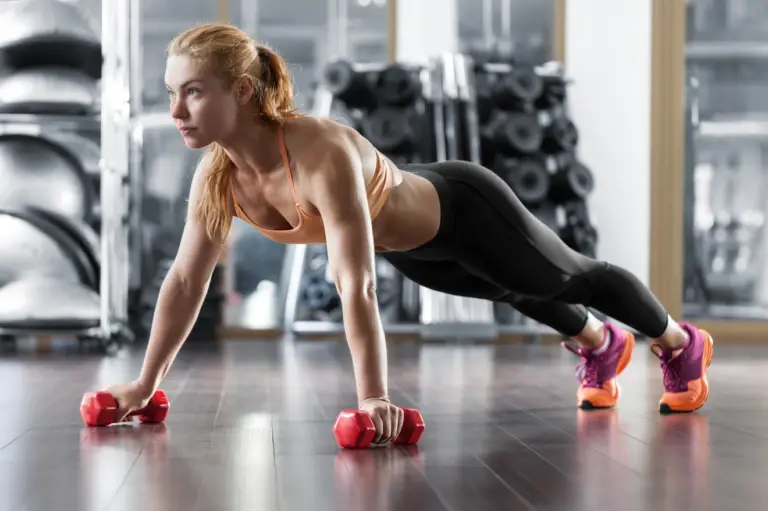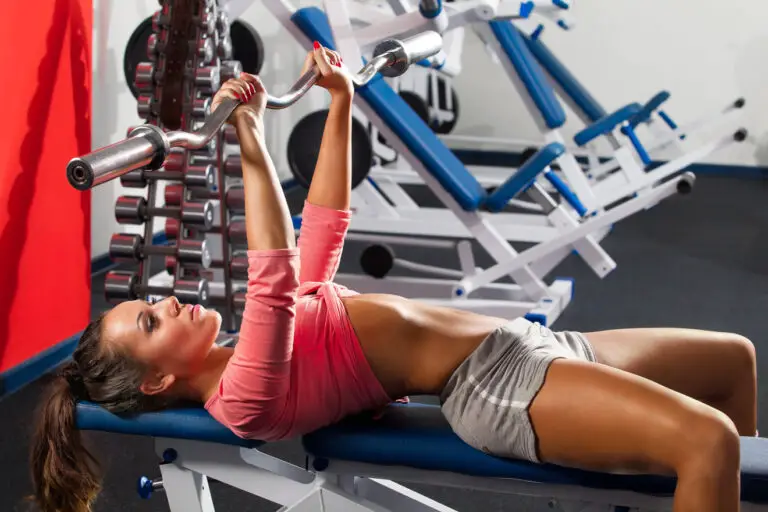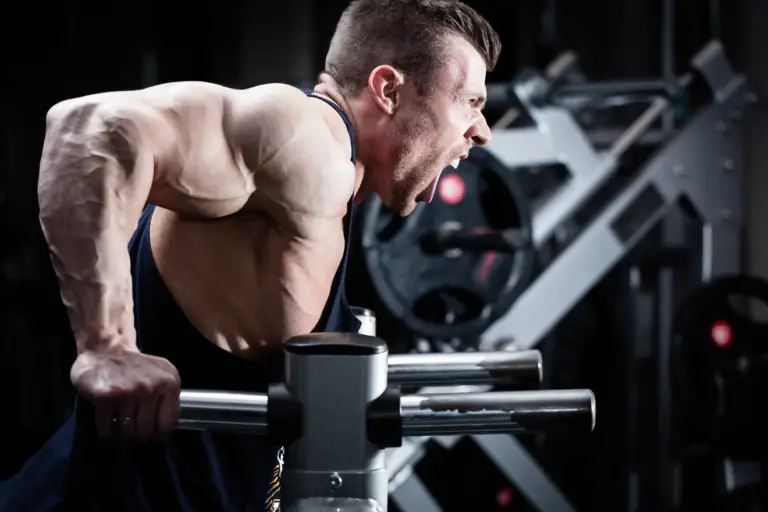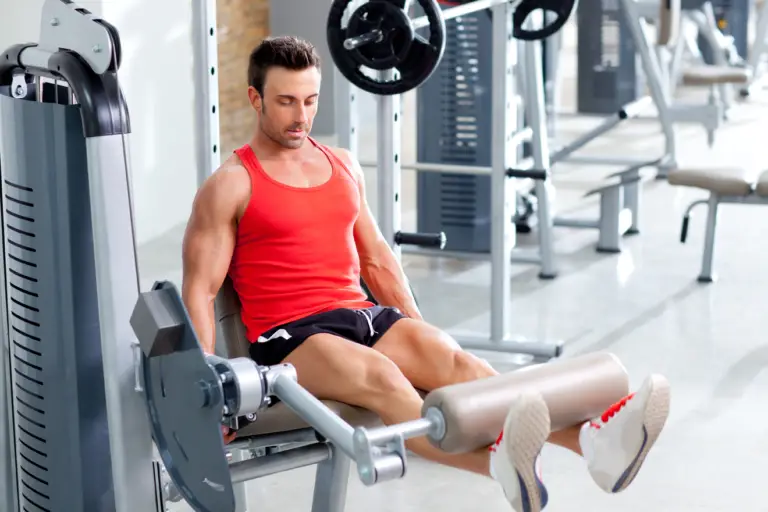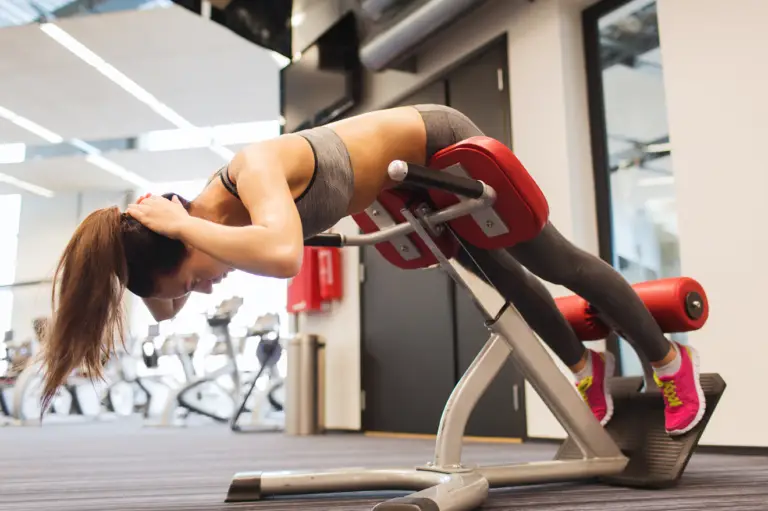Overview of women’s weight training programs
Programs for women
As summarized in Table 1 below, there are three weight training programs for women on this website.
Table 1. Summary of the three weight training programs for women, including each program’s duration, number of workouts per week, approximate workout duration, and whether the program can be repeated several times in succession. The workout duration does not include the warmup and post-workout stretch.
The same programs are also available in my ebook.
The first program, Maximum Curves and Functional Fitness (MCFF), actually consists of six smaller programs (mesocycles). As its name implies, MCFF is intended for women who want to develop maximum curves/shape and a functionally fit body.
The Women’s Plateau Buster is a stand-alone program that you can use if you ever experience a plateau (a plateau is when you stop making progress due to your body becoming adapted to the training stimulus). Since the program is designed to produce the same results as MCFF, you can also include it as part of MCFF and use it after MCFF 5.
The Women’s Time-Saver is another stand-alone program. It is designed to provide a quick and effective full-body workout for women who have very little time to spare for the gym.
You can complete the training programs at any gym or at home using the following equipment:
- An adjustable bench
- A set of dumbbells
- A barbell
- A power rack/cage for safety
- A pull-up bar
- A multipurpose cable machine OR a set of clip resistance bands
- Ankle straps
- Loop bands (optional)
- An ab wheel (optional)
- A stability ball (optional)
- Dip bars (optional)
All of the programs and the way they were designed will be explored in detail below.
General instructions
If a beginner, you should start with the Women’s Beginner mesocycle, after which you can either progress through the other mesocycles or jump to the Women’s Time-Saver program, depending on your preferences.
If experienced, you can start from any program that you choose as long as you meet the suitability criteria (see tables 2 and 3).
Maximum Curves and Functional Fitness (MCFF)
MCFF is a comprehensive long-term weight training program that was meticulously designed to:
- Develop and maintain major ‘curves’ or shape
- Strengthen your body’s primal movement patterns, thus improving your functional fitness, balance, coordination, athleticism, and performance
- Strengthen your core, which is important for stability, body-wide strength, power generation, and power transfer
- Encourage the right strength balances between your opposing muscle groups, which is important for proper posture and movement and to prevent imbalance-related injuries
The program achieves this by incorporating, or following, a combination of:
- Major compound (multi-joint) exercises
- Functional exercises
- Intensity techniques
- Undulating periodization
- Recommended muscle strength balance ratios
In programming terminology, MCFF is a macrocycle (‘big cycle’). The six individual programs that make up MCFF (from the Women’s Beginner program to MCFF 5) are known as mesocycles (‘middle cycles’). Although not expressed in Table 1, most of the mesocycles are themselves divided into microcycles (‘small cycles’). The mesocycles and microcycles incorporate variations in training, which will be explained in the mesocycle overview below.
MCFF lasts for a minimum of one year and 13 weeks if you move from mesocycle to mesocycle and take a deload week after each one. A deload week is a week during which you either rest or train lightly. However, apart from the Women’s Beginner mesocycle, you do not have to move from one mesocycle straight on to the next one. I balanced the exercises in each mesocycle as best as I could so that you can keep repeating each mesocycle over and over without much of a risk of developing muscular imbalances. As such, you can repeat each mesocycle as many times as you want to before moving on to the next one. This will ensure that you get the most out of each mesocycle and the macrocycle as a whole.
In fact, you don’t have to move on at all. If you enjoy a particular mesocycle, you can stick to it. Provided you keep increasing the amount of weight that you lift, as requested in the instructions of each mesocycle, you should see continual progress for a significant amount of time. Just make sure that you take a deload week before repeating a mesocycle or moving on to the next mesocycle.
Note that the deload weeks are important. Please do not ignore them. They will help you to fully recover and therefore keep making progress. They will also increase your likelihood of not giving up.
Mesocycle overview
Before I provide an overview of each mesocycle (Table 2), I remind you that training in different rep ranges leads to the development of different muscle properties. This was explained in How many sets and reps should I do?, in the Weight Training Guide.
More specifically:
- Using a weight with which you can perform 13–20 reps in good form is optimal for developing muscular endurance
- Using a weight with which you can only perform 6–12 reps in good form (i.e. a heavy weight) is optimal for developing muscular size
- Using a weight with which you can only perform 2–6 reps in good form (i.e. a very heavy weight) is optimal for developing muscular strength
Women’s Beginner
Focusing mostly on the 13+ rep range, the 12-week Women’s Beginner mesocycle is designed to build a strong foundation of muscular endurance upon which muscular size can be built in the more advanced mesocycles. It is intended for beginners, individuals who have less than three months of consistent weight training experience, and experienced gym-goers who haven’t trained for over three months.
Table 2. The rep ranges and intensity techniques of each MCFF mesocycle, along with the level of experience required to start from each mesocycle.
MCFF 1
The 8-week MCFF 1 mesocycle starts to build muscle in the 9–11 rep range. It also incorporates an intensity technique known as superset training. You can start from this mesocycle without having to go through the Women’s Beginner mesocycle only if you have at least three months of consistent weight training experience.
MCFF 2
The 10-week MCFF 2 mesocycle is composed of microcycles that alternate between the 9–11 and 6–8 rep ranges (you will learn below why rep ranges are alternated). This mesocycle includes an intensity technique known as training to failure. You can start from this mesocycle only if you have at least six months of consistent training experience.
MCFF 3
Like MCFF 2, the 10-week MCFF 3 mesocycle consists of microcycles that alternate between the 9–11 and 6–8 rep ranges. The mesocycle includes an intensity technique called dropset training. As with MCFF 2, you can start from this mesocycle only if you have at least six months of consistent weight training experience.
MCFF 4
As with MCFF 2 and MCFF 3, the 8-week MCFF 4 mesocycle consists of microcycles that alternate between the 9–11 and 6–8 rep ranges. It includes an intensity technique known as rest–pause training. You can start from this mesocycle only if you have at least nine months of consistent training experience.
MCFF 5
Although the 12-week MCFF 5 mesocycle also comprises microcycles that alternate between the 9–11 and 6–8 rep ranges, it is different from the other mesocycles in that all of the exercises are arranged into supersets. As such, the workouts are more intense and quicker to complete. You can start from this mesocycle only if you have at least 12 months of consistent weight training experience.
Why alternate between rep ranges?
The process of alternating rep ranges in microcycles is known as undulating periodization. Since training in different rep ranges leads to the development of different muscle properties (endurance, size, or strength), undulating periodization will help you to simultaneously develop and maintain different muscle properties.
In this instance, you will mostly be alternating between the 9–11 and 6–8 rep ranges, which are both primarily for building muscle and shape. However, the 9–11 rep range will help you to develop muscular size and maintain a bit of endurance, while the 6–8 rep range will help you to develop muscular size and more strength. The extra strength will assist you in lifting heavier weights, which will help your muscles to grow, which will, in turn, help you to lift even heavier weights — thus promoting a cycle of growth.
I could have had you also alternate the 13+ rep range for maintaining the endurance that you develop in the Women’s Beginner mesocycle, or I could have had you also alternate a 3–5 rep range for developing maximum strength. However, the endurance rep range would have significantly increased the time that it takes for you to build shape and curves (muscle), and the maximum strength rep range just doesn’t appeal to most women.
Overview of the other training programs for women
Women’s Plateau Buster
The 8-week Women’s Plateau Buster is your weapon for breaking out of plateaus, should they ever occur. You can also use it as if it’s the seventh MCFF mesocycle and repeat it as many times as you want to.
As with the MCFF mesocycles, the Women’s Plateau Buster consists of microcycles that alternate between the 9–11 and 6–8 rep ranges (Table 3). The difference is that most of the exercises are arranged in accordance with an advanced intensity protocol known as pre-exhaustion training, which will ensure that you partially exhaust prime mover muscles using isolation exercises before you move on to the main compound exercises. Pre-exhaustion of prime movers makes them work much harder during the compound exercises, thus amplifying the stimulus for development and increasing your chances of kick-starting stunted progress.
If you’re new to weight training and follow MCFF, you will almost certainly not need this program as a plateau buster for at least a couple of years. However, if you ever do need it, it should ensure that you keep making progress.
Table 3. The rep ranges and intensity techniques of the Women’s Plateau Buster and Women’s Time-Saver programs, along with the levels of experience required to start from each program.
Women’s Time-Saver
The 12-week Women’s Time-Saver is for you if you don’t have much time for workouts. Alternating between the 9–11 and 6–8 rep ranges, the workouts include the bare minimum of exercises and sets necessary to get an effective full-body workout and try to promote continual development. What’s more, the exercises are arranged into supersets, which means that you can fly through them very rapidly.
Apart from a few basic adjustments to emphasize glute development, the Women’s Time-Saver is similar to the Men’s Time-Saver program. As such, although it should take you quite far in terms of developing shape, it will not give you the kind of curves that you could get with MCFF.
You can repeat the Women’s Time-Saver program as many times as you want to. If a beginner, ideally, before you start the program, you should have completed at least microcycles 1 through 3 of the Women’s Beginner mesocycle. As with the Women’s Time-Saver workouts, the workouts of microcycles 1 through 3 of the Women’s Beginner mesocycle are short, and they will help you to develop a small foundation of muscular endurance upon which the Women’s Time-Saver program can build.
How do the women’s programs differ from the men’s ones?
Men and women usually train for different goals. Men usually want maximum muscle and strength, whereas women usually want maximum shape and ‘tone’. The training programs have been adapted to meet these different needs by incorporating different exercises and rep ranges.
It’s important to realize that maximum muscle (one of men’s goals) and maximum shape and tone (women’s goals) are actually achieved by doing the same two things:
- Losing body fat
- Adding muscle to specific areas of the body
Therefore, the men’s and women’s training programs follow the same primary strength and conditioning principles.
Ladies, this means that you have to train (and eat) for muscular growth, just like the men have to. In other words, in order to develop the shape and tone that you want, you have to lose the light dumbbells and hit heavier weights.
Will heavy lifting make me look bulky, like a man?
No, because women generally possess ten times less testosterone than men do, so you will likely never get to the stage where you look too bulky unless you train your socks off and take testosterone artificially. Also, women add muscle at a slower rate than men do, which means that you will have more than enough time to notice that you are getting too muscular, after which you can adjust your training.
Important!
Ladies, please do not be scared of heavy lifting. This fear will prevent you from getting the results that you want. If you want shape and tone, you have to build muscle in all of the right areas of your body, and the only way to do that is to lift heavier weights.
How the women’s programs were designed
Exercise selection
The goals of all the weight training programs for women are to develop and maintain curves and functional fitness, strengthen the body’s primal movement patterns, strengthen the core, and encourage the right strength balances between opposing muscle groups. Most of the exercises used in the programs were selected to meet those objectives. I explain how below. However, some exercises were included for other purposes, such as to prepare you in one mesocycle for more advanced exercises in the following mesocycle, or simply to add variation to the workouts to keep you engaged.
Balancing the exercises
When training, it’s important to develop a balanced musculature. Ideally, opposing muscle groups (for example, the flexors and extensors of your hip) should adhere to recommended muscle strength balance ratios. The reason is that, if opposing muscle groups develop significant differences in strength, performance can be jeopardized and the risk of sustaining injuries and developing problems related to muscle tightness, joint instability, posture, and gait can be increased.
Athletes prevent or fix imbalances in opposing muscle strength by approaching a personal trainer, who identifies the strength ratios of opposing muscle groups using one-repetition maximum testing and then prescribes a training program to fix any imbalances or ensure that imbalances are not developed. The least you can do as a gym-goer and fitness enthusiast who cares about her figure is follow weight training programs that are relatively balanced in terms of exercise selection, training volume and training intensity, thus reducing your likelihood of developing or exacerbating imbalances. This is especially important if you’re going to repeat the programs over and over again.
In order to reduce your likelihood of developing imbalances while using my programs, I designed them in accordance with the muscle strength balance ratios recommended by the International Fitness Professionals Association (IFPA; Table 4).
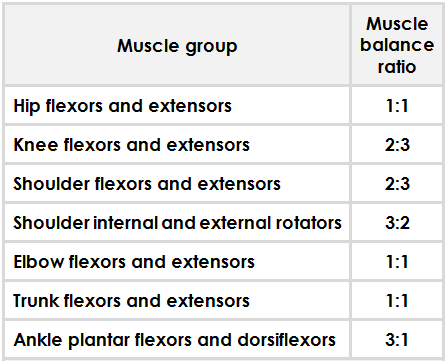
Table 4. Muscle strength balance ratios recommended by the IFPA.
The strategy that I used was to:
- Make note of the target and synergistic muscles of each exercise, as revealed on ExRx.net
- Ensure that the exercises, rep ranges, and number of sets prescribed for opposing muscle groups approximately satisfy the above ratios
For example, since the strength of your hip flexors and extensors should be equal, I tried to ensure that the exercises, rep ranges, and number of sets prescribed for these muscle groups deliver approximately equal muscular overload.
Note that balancing the Women’s Beginner program wasn’t as important as balancing the other programs, because the Women’s Beginner program isn’t intended to be repeated over and over again and is designed to prepare you for the subsequent programs. Even so, it is still relatively balanced.
Exercises for curves
Generally speaking, curves are the product of having a high shoulders-to-waist ratio and a low waist-to-hips ratio, producing the desired hourglass figure. In order to promote these ratios, I ensured that MCFF and the Women’s Plateau Buster program include an appropriate balance of exercises for shoulders, hips, inner and outer thighs, and especially glutes. Balancing these kinds of programs leads to complications, which I’d like to briefly share.
One of the complications is that many exercises that are great for glutes, such as the barbell squat and barbell lunge, are also great for quadriceps. Since most women don’t want big quadriceps, I prescribed variations of these exercises that emphasize glutes and hamstrings over quadriceps (such as the barbell sumo squat and the dumbbell forward-leaning lunge). All the while, I had to maintain the recommended quadriceps–hamstrings balance.
Another problem encountered when designing programs for curves is that the relatively large number of glute exercises have to be balanced with hip flexor exercises because the hip flexors are the opposing muscle group. The issue is that beginners with a weak rectus abdominis who perform lots of hip-flexion exercises using improper form can develop lower back problems because the rectus abdominis can’t counter the hip flexors’ pull on the lumbar spine. Therefore, I had to make sure that the Women’s Beginner mesocycle started by strengthening the rectus abdominis a little, before gradually easing hip flexion into the mix. Then, of course, I had to balance the ab exercises with exercises for the erector spinae, which oppose the abs and should ideally be equally as strong.
Exercises for functional fitness
Functional fitness is the kind of fitness that is useful outside of the gym, in everyday activities. You develop functional fitness by strengthening the ways in which your body is designed to move. The ways in which your body is designed to move can be broken down into seven ‘primal’ movement patterns:
- Squatting
- Lunging (forward, sideways, or backward)
- Hinging at the hips
- Pushing (horizontally or vertically)
- Pulling (horizontally or vertically)
- Twisting
- Walking/Jogging/Running (gait)
You use these primal movement patterns in various combinations every day of your life. By strengthening them, you not only develop a functionally strong body but also:
- Enhance your motor control, coordination, balance, and flexibility
- Become better equipped for everyday activities
- Improve your overall fitness and athleticism
Unfortunately, most training programs that you encounter do not cover these movement patterns. Instead, they focus on training muscles, often in isolation, which is not how the body is designed to work. Rest assured that the weight training programs on this website, together with the circuit training program in the Cardio Training Programs section, incorporate effective functional training and give you the benefits outlined above.
Exercises for strengthening the core
An important element of having a functionally strong body is to have a strong core. Your core isn’t just your rectus abdominis and lower back; it’s your entire torso, especially all of the deep muscles that attach to your spinal column and pelvis. Your core muscles help to:
- Stabilize your body when you lift
- Transfer weight from one side of your body to the other
- Transfer weight from your lower body to your upper body, and vice versa
Your core is also where you generate much of your power. As such, it acts as your power base, power transfer center, and stabilization facility. Having a strong core is therefore of major importance for progress and overall fitness and athleticism.
Proper core training involves performing a range of major compound and functional exercises designed to strengthen both the deep and superficial muscles of the core, ideally, both dynamically and isometrically. All of the weight training programs on this website incorporate effective dynamic core training, while some also include isometric core training.
Summary of programming rules and objectives
When designing the weight training programs for women, I tried to follow or satisfy the following rules and objectives:
- Train all muscle groups at least twice a week
- Strengthen all primal movement patterns using compound and functional exercises
- Prescribe exercises, sets, and rep ranges for opposing muscle groups in accordance with recommended muscle strength balance ratios
- Undulate rep ranges to simultaneously develop multiple muscle properties and maintain properties developed in previous mesocycles
- Strengthen the core using compound, functional, and unilateral exercises
- Train the core dynamically and isometrically
- Only include exercises the equipment for which should be available in any gym
- Incorporate exercise variation to maintain engagement
- Avoid exercises that have a high risk-to-benefit ratio, such as the narrow-grip upright row and behind-the-neck pulls and presses
- Favor free-weight exercises over machine exercises
- Avoid overworking the supraspinatus muscle, which is a common mistake
- Train large muscle groups before small muscle groups
- Prescribe more sets for large muscle groups than for small muscle groups
- Keep most workouts to approximately 18 or fewer sets, which produces workouts that last for approximately 50 minutes or less (the more advanced workouts include up to 21 sets)
- Force gradual but definite progress from mesocycle to mesocycle
- Ensure adequate rest by enforcing regular deload weeks
Alternative exercises
If you get bored of an exercise, or if you can’t perform an exercise for some reason, you can swap it for one of the alternative exercises below without significantly affecting the balance of your program. Note that, if you read the Muscle Activation Guide, you will have a better understanding of muscle activation, after which you will be able to identify alternative exercises by yourself.
Legs and glutes
- Hyperextension — Straight-leg deadlift
- Romanian deadlift — Cable pull-through
- Squat — Front squat — Hack squat — Sumo squat — Zercher squat — Jefferson squat
- Forward/Rear/Side lunge — Step-up — Split squat — Bulgarian split squat
- Lying leg curl — Seated leg curl — Inverse leg curl
- Machine standing calf raise — Standing one-leg dumbbell calf raise — Leg-press calf press
- Barbell hip thrust — Barbell glute bridge
- Cable standing hip abduction — Machine seated hip abduction — Side plank hip abduction
- Cable standing hip adduction — Machine seated hip adduction — Side plank hip adduction
Back
- Lat pull-down — Pull-up
- Bent-over dumbbell row — Barbell row — T-bar row — Seated cable row — Inverted row
Chest
- Bench press — Push-up — Cable/Machine chest press
Shoulders
- Overhead press — Shoulder press — Arnold press — Pike press
- Cable face pull — Dumbbell face pull — Cuban rotation
- Lying dumbbell external shoulder rotation — Cable external shoulder rotation
Arms
- Triceps rope push-down — Dumbbell/Cable kickback — Triceps overhead extension — Lying triceps extension — Skull crusher
- Triceps dip — Bench dip — Diamond push-up — Close-grip bench press/push-up
- Dumbbell/Barbell curl — EZ bar curl (bar must have minimal camber)
Core
- Front plank — Ab walkout — Inch worm — Wheel rollout
- Cable wood chop — Weighted Russian twist — Weighted lying oblique twist
- Lying leg raise — Hanging leg raise — Captain’s chair leg raise
- Lying straight leg raise — Hanging straight leg raise — Captain’s chair straight leg raise — Stability ball pike
- Lying leg and hip raise — Hanging leg and hip raise — Captain’s chair leg and hip raise

